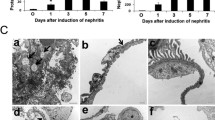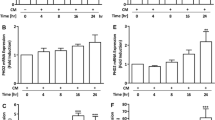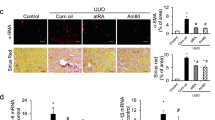Abstract
Sustained high output release of Nitric oxide (NO) as result of activation of inducible nitric oxide synthase (iNOS), and increased production of the antiproliferative/profibrotic cytokine transforming growth factor-β1 (TGF-β1) are well documented in glomerulonephritis. Modulation of iNOS activity and of TGF-β1 production can therefore be viewed as anti-inflammatory strategies. The present study employed all-trans retinoic acid (atRA) which is known to have anti-inflammatory effects and to modulate expression of iNOS and TGF-β1, in order to explore its effect on iNOS enzyme activity and TGF-β1 production in anti-GBM antibody induced glomerulonephritis. Glomerulonephritis was induced in Lewis rats by injection of anti-GBM antibody. A group of nephritic rats were given daily administration of atRA for 14–16 days. Extent of proteinuria was assessed by measuring urine protein and creatinine excretion. iNOS enzyme activity was measured by calculating conversion of L[14C]arginine to L-[14C]citrulline in glomerular protein lysates. Levels of TGF-β1 in glomerular protein lysates were measured by quantitative ELISA. Levels of proliferating nuclear antigen (PCNA), TGF-β receptor II (TGFβ-RII), and fibronectin were assessed by Western blot analysis. Glomerular iNOS activity in atRA treated nephritic animals was attenuated in comparison to that in nephritic controls that were not. Glomerular expression of PCNA was also reduced. Levels of TGF-β1 were increased in glomeruli of atRA treated nephritic animals. In these animals, there was no change in glomerular levels of TGF-β receptor II (TGFβ-RII) or fibronectin, and there was no reduction in urine protein excretion. These results suggest that atRA attenuates iNOS activity and proliferation in glomeruli of nephritic animals. The failure of atRA treatment to reduce proteinuria could be due to the increase in TGF-β1 levels and to inhibition of iNOS-driven NO production.
Similar content being viewed by others
References
Cattell, V., E. A. Lianos, P. Largen, and T. Cook. 1993. Glomerular NO synthase activity in mesangial cell immune injury. Exp. Nephrol. 1:36–40.
Cook, H. T., H. Ebrahim, A. S. Jansen, G. R. Foster, P. Largen, and V. Cattell. 1994. Expression of the gene for inducible nitric oxide synthase in experimental glomerulonephritis in the rat. Clin. Exp. Immunol. 97:315–320.
Narita, I., W. A. Border, M. Ketteler, and N. A. Noble. 1995. Nitric oxide mediates immunologic injury to kidney mesangium in experimental glomerulonephritis. Lab. Invest. 72:17–24.
Lianos, E. A., and J. Liu. 1997. Changes in inducible nitric oxide synthase expression in experimental glomerulonephritis. Proc. Soc. Exp. Biol. Med. 215:405–411.
Furusu, A., M. Miyazaki, K. Abe, S. Tsukasaki, K. Shioshita, O. Sasaki, K. Miyazaki, Y. Ozono, T. Koji, T. Harada, H. Sakai, and S. Kohno. 1998. Expression of endothelial and inducible nitric oxide synthase in human glomerulonephritis. Kidney Int. 53:1760–1768.
Datta, P. K., S. B. Koukouritaki, K. A. Hopp, and E. A. Lianos. 1999. Heme oxygenase-1 induction attenuates inducible nitric oxide synthase expression and proteinuria in glomerulonephritis. J. Am. Soc. Nephrol. 10:2540–2550.
Moncada, S., R. M. J. Palmer, and E. A. Higgs. 1991. Nitric oxide: Physiology, pathophysiology and pharmacology. Pharmacol. Rev. 43:109–142.
Xie, Q., and C. Nathan. 1994. The high-output nitric oxide pathway: Role and regulation. J. Leukoc. Biol. 56:576–582.
Okuda, S., L. R. Languino, E. Ruoslahti, and W. A. Border. 1990. Elevated expression of TGF-b and proteoglycan production in experimental glomerulonephritis. J. Clin. Invest. 86:453–462.
Shankland, S. J., J. Pippin, R. H. Pichler, K. L. Gordon, S. Friedman, L. I. Gold, R. J. Johnson, and W. G. Couser. 1996. Differential expression of transforming growth factor-b isoforms and receptors in experimental membranous nephropathy. Kidney Int. 50:116–124.
Roberts, A. B., B. K. McCune, and M. B. Sporn. 1992. TGF-beta: Regulation of extracellular matrix. Kidney Int. 41:557–559.
Border, W. A., S. Okuda, L. R. Languino, M. B. Sporn, and E. Ruoslahti. 1990. Suppression of experimental glomerulonephritis by antiserum against TGF-b. Nature 346:371–374.
Brinckerhoff, C. E., J. W. Coffey, and A. C. Sullivan. 1983. Inflammation and collagenase production in rats with adjuvant arthritis reduced with 13-cis-retinoic acid. Science 221:756–758.
Orfanos, C. E., and R. Bauer. 1983. Evidence for antiinflammatory activities for oral and synthetic retinoids: Experimental findings and clinical experience. Br. J. Dermatol. S25:55–60.
Mehta, K., T. McQueen, S. Tucker, R. Pandita, and B. B. Aggarwal. 1994. Inhibition by all-trans retinoic acid of tumor necrosis factor and nitric oxide production by peritoneal macrophages.J. Leukoc. Biol. 55:336–342.
Mangelsdorf, D. J., K. Umesono, and R. M. Evans. 1994. The retinoid receptors. In: Sporn MB, Roberts AB, and Goodman DS, eds. The Retinoids: Biology, Chemistry and Medicine, New York: Raven Press; 319–359
Zhang, X., J. Lehmann, B. Hoffmann, M. I. Dawson, J. Cameron, G. Graupner, T. Hermann, P. Tran, and M. Pfhal. 1992. Homodimer formation of retinoid receptor induced by 9-cis-retinoic acid. Nature 358:587–591.
Schule, R., P. Rangarajan, N. Yang, S. Kliewer, L. J. Ransone, J. Bolado, I. M. Verma, and R. M. Evans. 1991. Retinoic acid is a negative regulator of AP-I responsive genes. Proc. Natl. Acad. Sci.USA 88:6092–6096.
Nicholson, R. C., S. Mader, S. Nagpal, M. Lied, C. Rochette-Egly, and P. Chambon. 1990. Negative regulation of the rat stromelysin gene promoter by retinoic acid is mediated by an AP1 binding site. EMBO J. 9:4443–4454.
Ward, A., R. N. Brogden, R. C. Heel, T. M. Speight, and G. S. Avery. 1983. Etretinate: A review of its pharmacological properties and therapeutic efficacy in psoriasis and other skin disorders. Drugs 26:9–43.
Peck, G. L., T. G. Olsen, D. Butkus, M. Pandya, J. Arnaud-Battandier, E. G. Gross, D. B. Windhorst, and J. Cheripko. 1982. Isotretinoin versus placebo in the treatment of cystic acne. A randomized double-blind study. J. Am. Acad. Dermatol. 6:735–745.
Brinckerhoff, C. E. 1990. Retinoids and rheumatoid arthritis: modulation of extracellular matrix by controlling expression of collagenase. Methods Enzymol. 190:175–188.
Hirokawa, K., K. M. O'shaughnessy, P. Ramrakha, and M. R. Wilkins. 1994. Inhibition of nitric oxide synthesis in vascular smooth muscle by retinoids. Br. J. Pharmacol. 113:1448–1454.
Datta, P. K., and E. A. Lianos. 1999. Retinoic acids inhibit inducible nitric oxide synthase expression in mesangial cells. Kidney Int. 54:486–493.
Bokemeyer, D., K. E. Guglielmi, A. McGinty, A. Sorokin, E. A. Lianos, and M. J. Dunn. 1997. Activation of extracellular signalregulated kinase in proliferative glomerulonephritis in rats. J. Clin. Invest. 100:582–588.
Schecklmann, H. O., H. D. Rupprecht, I. Zauner, and R. B. Sterzel. 1997. TGF-b1 induced cell cycle arrest in renal mesangial cells involves inhibition of cyclin E-CDK2 activation and retinoblastoma protein phosphorylation. Kidney Int. 51:1228–1236.
Polyak, K. 1996. Negative regulation of cell growth by TGF beta. Biochim. Biophys. Acta. 1242:185–199.
Pfeilschifter, J., and K. Vosbeck. 1991. Transforming growth factor beta 2 inhibits interleukin I beta and tumor necrosis factor alphainduction of nitric oxide synthase in rat mesangial cells. Biochem. Biophys. Res. Commun. 175:372–379.
Massague, J. 1998. TGF-b signal transduction. Annu. Rev. Biochem. 67:753–759.
Choi, M. E., E. G. Kim, Q. Huang, and B. J. Ballermann. 1993. Rat mesangial cell hypertrophy in response to transforming growth factor-beta 1. Kidney Int. 44:948–958.
Xiong, Y., H. Zhang, and D. Beach. 1992. D type cyclins associate with multiple protein kinases and the DNA replication and repair factor PCNA. Cell 71:505–514.
Wan, Y. J.-Y., L. Wang, and T. C. J. Wu. 1992. Detection of retinoic acid receptor mRNA in rat tissues by reverse transcriptasepolymerase chain reaction. J. Mol. Endocrinol. 9:291–294.
Yang, T., D. E. Michele, J. Park, A. N. Smart, Z. Lin, F. C. Brosius, III, J. B. Schnermann, and J. P. Briggs. 1999. Expression of peroxisomal proliferator-activated receptors and retinoid X-receptors in the kidney. Am. J. Physiol. 46:F966–F973.
Tzimas, G., R. Thiel, I. Chahoud, and H. Nau. 1997. The area under the concentration-time curve of all-trans-retinoic acid is the most suitable pharmacokinetic correlate to the embryotoxicity of this retinoid in the rat. Toxicol. Appl. Pharmacol. 143:436–444.
Falk, L. A., F. Benedetti, N. Lohrey, M. C. Birchenall-Roberts, L. W. Ellingsworth, C. R. Faltynek, and F. W. Rusetti. 1991. Induction of TGF-b1 receptor expression and TGF-b1 protein production in retinoic acid treated HL-60 cells: possible TGF-b1 mediated autocrine inhibition. Blood 77:1248–1253.
Roberts, A. B., and M. B. Sporn. 1992. Mechanistic interrelationships between two superfamilies: The steroid/retinoid receptors and transforming factors. Cancer Surv. 14:205–220.
Jakowlew, S. B., J. Cubert, D. Danielpour, M. B. Sporn, and A. B. Roberts. 1992. Differential regulation of the expression of transforming growth factor-beta mRNAs by growth factors and retinoic acid in chicken embryo chondrocytes, myocytes, and fibroblasts. J. Cell. Physiol. 150:377–385.
Okuno, M., H. Moriwaki, S. Imai, Y. Muto, N. Kawada, Y. Suzuki, and S. Kojima. 1997. Retinoids exacerbate rat liver fibrosis by inducing the activation of latent TGF-b in liver stellate cells. Hepatology 26:913–921.
Lianos, E. A., V. Orphanos, V. Cattell, T. Cook, and N. Anagnou. 1994. Glomerular expression and cell origin of transforming growth factor-b1 in anti-glomerular basement membrane disease. Am. J. Med. Sci. 307:1–6.
Vodovotz, Y. 1997. Control of nitric oxide production by transforming growth factor-b1: Mechanistic insights and potential relevance to human disease. Nitric Oxide 1:3–17.
Xie, Q. W., Y. Kashiwabara, and C. Nathan. 1994. Role of transcription factor NF-kappa B/rel in induction of nitric oxide synthase. J. Biol. Chem. 269:4705–4708.
Yoshizawa, M., H. Miyaki, and S. Kojima. 1998. Retinoids potentiate transforming factor-beta activity in bovine endothelial cells through up-regulating the expression of transforming growth factor-beta receptors. J. Cell. Physiol. 176:565–573.
Roulot, D., A.-M. Sevcsik, T. Coste, A. D. Strosberg, and S. Marullo. 1999. Role of transforming growth factor b type II receptor in hepatic fibrosis: studies of human chronic hepatitis C and experimental fibrosis in rats. Hepatology 29:1730–1738.
Lianos, E. A., G. A. Andres, and M. J. Dunn. 1983. Glomerular prostaglandin and thromboxane synthesis in rat nephrotoxic serum nephritis. Effects on renal hemodynamics. J. Clin. Invest. 72:1439–1448.
Zheng, Y., P. M. Kramer, G. Olson, R. A. Lubet, V. Steele, G. J. Kelloff, and M. A. Pereira. 1997. Prevention by retinoids of azoxymethane-induced tumors and aberrant crypt foci and their modulation of cell proliferation in the colon of rats. Carcinogenesis 18:2119–2125.
Ninomiya, Y., R. Adams, G. M. Morriss-Kay, and K. Eto. 1997. Apoptotic cell death in neuronal differentiation of P19 EC cells: cell death follows reentry into S phase. J. Cell. Physiol. 172:25–32.
Wagner, J., C. Dechow, C. Morath, I. Lehrke, K. Amann, R. Waldherr, J. Floege, and E. Ritz. 2000. Retinoic acid reduces glomerular injury in a rat model of glomerular damage. J. Am. Soc. Nephrol. 11:1479–1487.
Lianos, E. A., K. Guglielmi, and M. Sharma. 1998. Regulatory interactions between inducible nitric oxide synthase and eicosanoids in glomerular immune injury. Kidney Int. 53:645–653.
Cattell, V., H. T. Cook, H. Ebrahim, S. N. Waddington, X. Q. Wei, K. J. M. Assmann, and F. Y. Liew. 1998. Anti-GBM glomerulonephritis in mice lacking nitric oxide synthase type 2. Kidney Int. 53:932–936.
Shah, S. V. 1995. The role of reactive oxygen metabolites in glomerular disease. Annu. Rev. Physiol. 57:245–262.
Wink, D. A., J. A. Cook, R. Pucelli, P. S. Liebmann, M. C. Krishnan, and J. B. Mitchell. 1995. Nitric oxide protects against cellular damage by reactive oxygen species. Toxicol. Lett. 82:221–226.
Border, W. A., S. Okuda, L. R. Languino, M. D. Sporn, and E. Ruoslahti. 1990. Suppression of experimental glomerulonephritis by antiserum against transforming growth factor-β1. Nature 346:371–374.
Nakamura, T., D. Miller, E. Ruoslahti, and W. A. Border. 1992. Production of extracellular matrix by gomerular epithelial cells is regulated by transforming growth factor-β1. Kidney Int. 41:1213–1221.
Wicke, C., B. Halliday, D. Allen, N. S. Roche, H. Scheuenstuhl, M. M. Spencer, and A. B. Roberts. 2000. Effects of steroids and retinoids on wound healing. Archives of Surgery 135(11):1265–1270.
Author information
Authors and Affiliations
Rights and permissions
About this article
Cite this article
Datta, P.K., Reddy, R.S. & Lianos, E.A. Effects of All-Trans-Retinoic Acid (atRA) on Inducible Nitric Oxide Synthase (iNOS) Activity and Transforming Growth Factor Beta-1 Production in Experimental Anti-GBM Antibody-Mediated Glomerulonephritis. Inflammation 25, 351–359 (2001). https://doi.org/10.1023/A:1012888029442
Issue Date:
DOI: https://doi.org/10.1023/A:1012888029442




